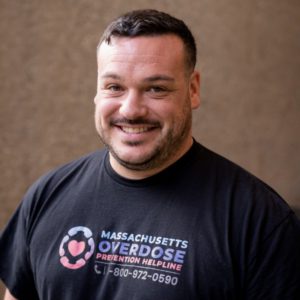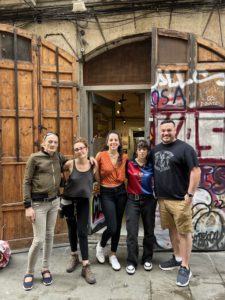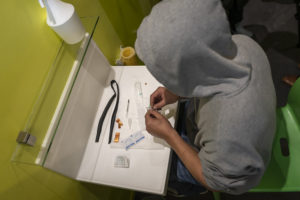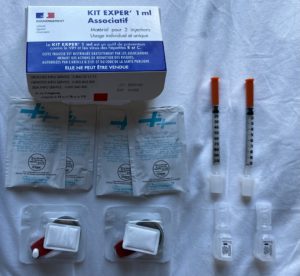14 March 2024
 Stephen Murray is director of the Massachusetts Overdose Prevention Helpline and Harm Reduction Program Manager at Boston Medical Center. He was also a recipient of a Policy, Program and Practitioner Scholarship to INHSU 2023, held in Geneva, Switzerland, last October. As part of his journey to Geneva, he visited three Overdose Prevention Sites across Europe and attended multiple sessions about the subject throughout the conference. His aim? To learn as much as he could about these life-saving interventions and advocate for them at home. Let’s find out more…
Stephen Murray is director of the Massachusetts Overdose Prevention Helpline and Harm Reduction Program Manager at Boston Medical Center. He was also a recipient of a Policy, Program and Practitioner Scholarship to INHSU 2023, held in Geneva, Switzerland, last October. As part of his journey to Geneva, he visited three Overdose Prevention Sites across Europe and attended multiple sessions about the subject throughout the conference. His aim? To learn as much as he could about these life-saving interventions and advocate for them at home. Let’s find out more…
As I embarked on my scholarship trip to the INHSU conference in Geneva in October 2023, some of the most profound experiences would come from my visits to three harm reduction sites across Europe.
I have been an outspoken advocate for overdose prevention sites here in Massachusetts over the last several years and have testified in support of them twice in the Massachusetts State House. However, I had never had the chance to visit one in person, so during my trip, I made sure to visit three sites in three countries that all had a different approach. As the director of a virtual overdose prevention hotline, the Massachusetts Overdose Prevention Helpline, I am always trying to learn from our friends abroad to try to find new and innovative solutions we can use in our fight against the overdose crisis.
These are my key takeaways from each of the Overdose Prevention Centre sites I visited.
Metzineres: An Oasis in Barcelona

My first stop was at the Metzineres harm reduction program in Barcelona, Spain. Nestled in the heart of the city, this facility exuded a feeling of warmth and compassion. As I entered, I was greeted by a dedicated team committed to providing a safe haven for women and gender-diverse people who use drugs.
It was immediately clear to me that this facility was more than just a place to prevent overdoses; it was a community hub offering support, respite, resources, food, safety, and education. The staff spoke passionately about their work, emphasizing the importance of building trust with their participants.
One of the things that struck me about this site is that there was no formal spot for drug consumption. People could use pretty anywhere on the site, and thanks to the layout and design, staff could easily monitor the entire facility.
People could use sitting on a couch, outside in the protected courtyard, or at the dining room table. This style of consumption space was very welcoming, relaxed, and non-medicalized. It is also worth noting that most of the drug consumption rooms around the world are not designed exclusively for women or gender-diverse people who use drugs, and this was a special place because of it.
Quai 9 Drug Consumption Room: Bridging Gaps in Geneva
 During the pre-conference events, I had the opportunity to tour the Quai 9 drug consumption room in Geneva, Switzerland, along with other conference attendees with lived experience. Situated close to the downtown train station, it seemed that the location had been well thought out. It has a very cool exterior design and looks like stacked containers. I arrived just around sunrise and snapped a cool picture. This site has been around for decades.
During the pre-conference events, I had the opportunity to tour the Quai 9 drug consumption room in Geneva, Switzerland, along with other conference attendees with lived experience. Situated close to the downtown train station, it seemed that the location had been well thought out. It has a very cool exterior design and looks like stacked containers. I arrived just around sunrise and snapped a cool picture. This site has been around for decades.
The inside felt both like a clinical environment but also was small enough that it felt welcoming. This location was set up exactly how I had imagined that most supervised sites would be – it had personalized desks for injection, which were easy to observe, clean, and with good lighting.
There was also a safer smoking room, which our host told us was so popular that they had to shut it down in order to get approval to develop a larger space. The increase in smoking as a route of consumption across the world is definitely evident in our data (including as the primary route in overdose in the United States, according to a recent CDC report). Including robust, safer smoking spaces is essential to the development of these programs.
One of the American visitors who was there with me asked if they had seen any xylazine in their drug supply – which they had not, and at that point, they had still seen relatively little fentanyl. This is a stark contrast to what we see in the drug supply in the United States. The other remarkable thing was that they did not have any naloxone on site and only saw around fifty overdoses per year. This speaks to the quality and predictability of the potency of the drug supply in Switzerland.
Pause Diabolo in Lyon: A Syringe Program with Limited Injection Supervision
 My final stop on this eye-opening journey was in Lyon, France, where I encountered the unique approach of Pause Diabolo. Pause Diabolo was mostly a syringe exchange/harm reduction program with a new component of limited injection supervision. I had an excellent visit with the staff at the facility and was struck by how warm and welcoming the space was.
My final stop on this eye-opening journey was in Lyon, France, where I encountered the unique approach of Pause Diabolo. Pause Diabolo was mostly a syringe exchange/harm reduction program with a new component of limited injection supervision. I had an excellent visit with the staff at the facility and was struck by how warm and welcoming the space was.
They had a few areas to sit on couches, an exchange area for supplies, a kitchen, bathrooms, and private consultation rooms. They are doing some limited supervised consumption using “injection technique inspection” where they watch someone go through their entire process of injection.
This is a way for them to give feedback on how the person is injecting or prepping their site to reduce risks of infection, extravasation, or other injection-related harms. It is also a supervised interaction in case of overdose. Another innovation they had done was to create small injection kits to give to pharmacies in the area. This expanded their geographic reach beyond their own brick-and-mortar site and also took advantage of the evening and weekend hours of local pharmacies. People could access these kits for free at any of the participating pharmacy locations.
Final thoughts
In conclusion, my visits to these overdose prevention sites during the INHSU conference in Geneva opened my eyes to the incredible work being done across Europe in the field of harm reduction and overdose prevention. As I left each facility, I carried with me a renewed sense of hope and a commitment to advocate for harm reduction strategies that prioritize the dignity and well-being of every individual. I am so thankful to INHSU for this scholarship opportunity!
If you’d like to know more about Overdose Prevention Sites, search posters and abstracts on the subject from INHSU 2024 over on the Conference Archive or download our Policy Brief on the subject here.

